Lesson 1 JSS3-Basic Technology
Date:06/08/2020
Topic: Freehand sketching
Freehand sketching is a method of drawing of objects without the use of Measuring instruments. It involves the use of Freehand and HB pencil.
See below the examples of Freehand sketching of some work shop tools:
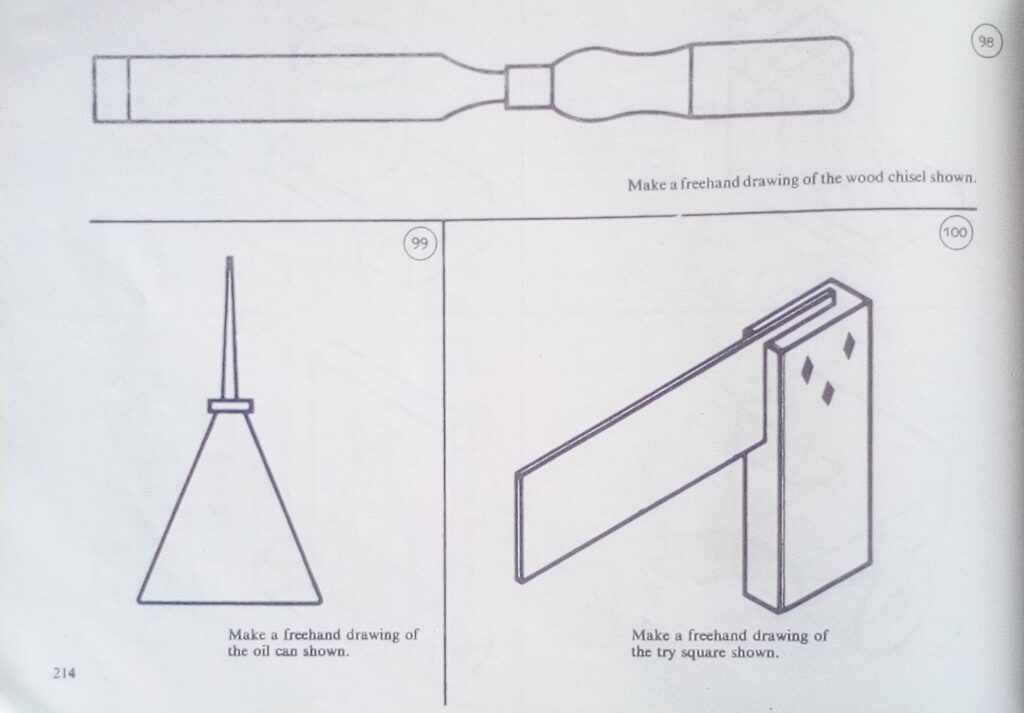
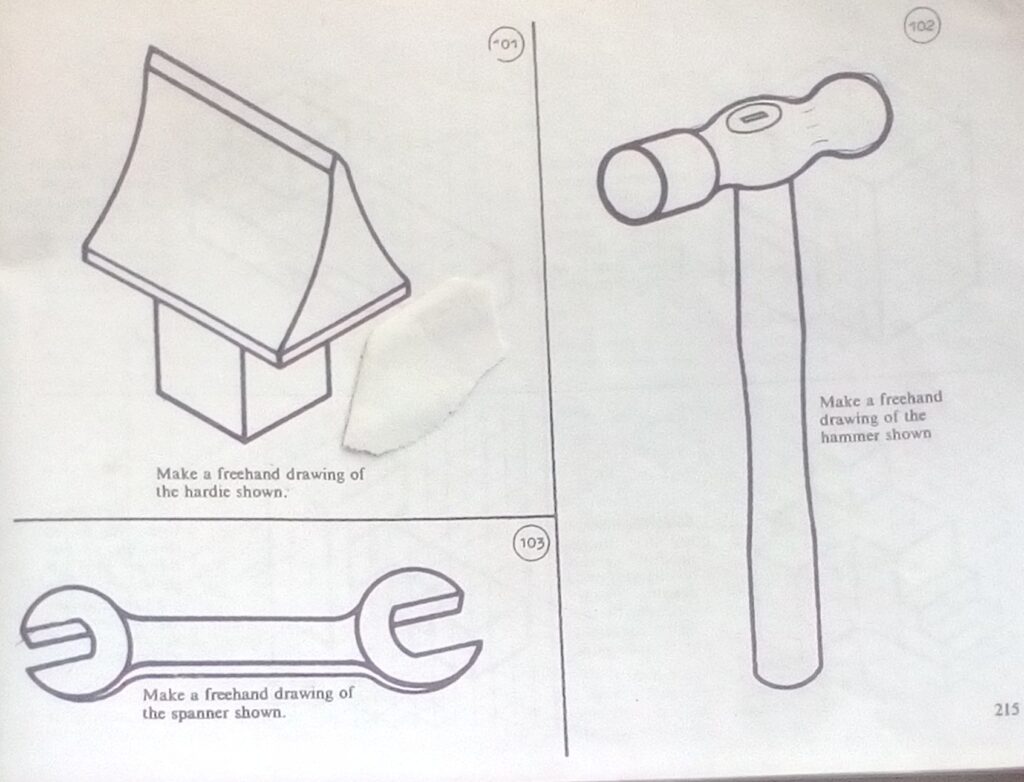
Assignment
Make a free hand sketching of the following instruments:
- G clamp
- F clamp
- Open ended spanner
- T square
- Inside caliper
- Spade
- Shovel
- Hand Trowel
- Digger
- Rake
Lesson 2
Date:06/08/2020
Topic: LETTERINGS
Good lettering and neat line work are very pleasing to look at on a drawing, and constant practice aimed at producing plain, clear figures will result in the attainment of a good standard.
Always print between two construction lines.
Types of lines
- Thick lines for outlines
- Thin lines for dimension lines, projection lines construction lines, hatching lines.
- Thin short dashes for hidden details.
- Thin long chain for Centre lines, pitch circles,path lines for indicating movement.
- Thick long chain for cutting planes and viewing planes.
- Ruled line and short zigzag for long break lines
- Thick wavy line for short break lines and irregular boundary lines.
Assignment
State the uses of following instruments and materials:
- T square
- Inside caliper
- HB pencil
- 2H pencil
- Compass
Using the form or email below:
akinsamgambol@gmail.com
Write your name,subject, class ,topic and email
Hello students. How are you doing.? I Hope the lockdown has not disoriented you. You are welcome to this platform. Now, let’s get down to business. We shall be reviewing and revising our Geometrical construction work in preparation for the forthcoming NECO EXAMINATIONS while staying safe at home.
Lesson 1
Jss 3- Basic technology
Date:28/07/2020
Topic: Transmission of Electricity at low Frequency
Transmission of electricity at low frequency refers the process of conveying the electricity generated at the power station to consumers in various homes and industries.
Method of Generating Electricity.
- By Hydro-power: This is a method of generating of electricity by the use of water e.g power station at kanji dam Niger state.
- By thermal (heat):This can be generated by the following;
a .By burning gas
b. By burning coal - By solar Energy
- By Nuclear Energy
- By Thermocouple
- By cells(batteries)
- By Alternating current(A.C)
Components of Electricity transmission at low Frequency
1.Generator control panel
2.circuit breaker
3.Sub station
4.Transformer
I. Step up transformer
II. Step down transformer - Transmission lines (or cables)
- Line Support/poles
- Insulators
I. porcelain(glazed brown)
II.Glass - Lightning Arrestor
- Protective device e.g fuses and circuit breaker.
- Feeder Pillars
- Ring Main Unit
- Bus-bar chamber and fuse Board
Assignment - Define transmission of electricity.
- What is the function of a fuse in a circuit.
- What is the difference between a fuse and a circuit breaker.
Lesson 2
Date:30/07/ 2020
Topic: Distribution of
Distribution of electricity refers to the supply of electricity to various consumers in homes and industries. The electricity current that is generated and supplied to the National grid by power holding company of Nigeria (PHCN) is Alternating current (A.C), and it’s distribution to consumers are available in the following supply system;
a. Single phase 2 wire
b. Single phase 3 wire
c. Three phase 3 wire
d. Three phase 4 wire
e. Three phase 4 wire system is the one that is widely used. This is because other systems can be obtained easily from this system.
The method of electricity distributing in Nigeria by PHCN is by overhead lines that are run on ceramic insulators (pin-type) which are fixed on cross arms of the line Support. These support can either be wooden poles or reinforce concrete poles, of minimum height of 10m.
Assignment
- Explain how Electricity is being distributed.
- What type of phase commonly used in Nigeria electricity supply system and why?
- Sketch the following electrical conventional symbols:
Switch , AIternating current, Direct current, filament lamp and socket plug.
Using the form and email below: akinsamgambol@gmail.com
Write your name, subject, class, topic and email.
Lesson 1
JSS3- Basic Technology
Date: 14/07/2020
Topic: Portable Power Tools
Portable power hand tools are tools powered by electric motors which makes work easier and faster than ordinary or manual hand tools. They can at same time be carried by hand. These portable hand tools are:
- Hand drill: lt is used to bore holes in wood.
- Belt sander: lt is used for sanding or smoothening the surface of wood.it has 2 rollers coated with abrasive.
- Circular saw: lt is used for cutting wood.
- Nailing gun machine: lt is used for nailing wood instead of the manual hammering method of nailing wood.
Assignment
- State the difference between ordinary hand tools and powered hand tools
- Mention 2 portable powered hand tools you know with diagram.
- Define sanding and state its uses. Lesson 2
Date: 16/07/2020
Topic: Wood work Machines
Wood work Machines are heavier stationary machines that use electricity and are sometimes installed into the ground, used for working on wood.
The following are some wood work Machines and their uses:
- Circular sawing machine: lt is used for cutting across and along the grain of wood.
- Band sawing machine: lt is used for cutting curves and straight lines in thick and thin pieces of wood.
- Surface planer machine: lt is used for planing wood surface.
- Thicknessing machine: lt is used for planing to specific thickness.
- Drill press: lt is used for drilling holes in to the wood.
- Wood lathe: lt is used for turning wood.
Assignment
- What is the difference between a portable powered tools and wood work machine.
- What is powered hack saw is used for?
- State 3 precautionary measures put in place when working in the woodwork shop.
the form or email below:
akinsamgambol@gmail.com
Write your name, subject, class, topic and email.
Lesson 1
JSS3- Basic Technology
Date: 07/07/2020
Topic: NECO Past Questions
Essay
- List any 4 factors responsible for collapsing of a building structure.
2.Enumerate 2 solutions to prevent building from collapsing. - What is forging?
4.List any 3 forging operations.
Solution - Factors responsible for collapsing of a building structure are:
a. Shallow depth of concrete foundation base.
b. Poor quality of building materials.
c. Improper construction of the building. d.Poor soil or weak soil.
e. Vibration as a result of Earth movement. - Solution to prevent building from collapsing are:
a.Basic standard materials must be used for building.
b. Erection of good solid foundation
c. Provision of qualified building engineers for expert advice. - Forging is the hammering of hot or cold metals into a certain shape.
4.Forging operations are:
Bending, Twisting, Upsetting, Drawing out & Forming.
Assignment - Mention 2 ways of maintaining house hold air conditioner.
- State 2 safety precautions in an auto workshop.
- The primary voltage and windings of a transformer are 200V and 100turns respectively. What is the secondary voltage if the secondary winding is 5turns.
Lesson 2
Date: 09/07/2020
Topic: NECO Past Questions 2
ESSAY
- Mention 2 advantages of friction.
- A machine has a machanical advantage of 2.5. what effort will require to lift a load of 500g.
- List 3 methods of food preservation.
- Name 2 systems of disposing human waste.
- List 3 materials used for concreting.
- State 4 primary sources of energy.
Solution
1.Advantages of friction are:
a. It aids walking and running
b. It helps to drive cars, ride on bicycles
c.it makes bolt and nuts stay together
d. It makes tyres vehicles grip the ground firmly.
e. It enables us to sharpen knives, chisels and cutting tools with grounding stones.
- Effort= Load ÷mechanical advantage
= 500kg÷ 2.5
Effort=200newtons
3.Methods of food preservation are:
a. By drying
b. By smoking
c. By canning
d. By pasteurization
e. By refrigeration
- Systems of disposing human waste are:
a. By burying underground
b. By composting with refuse.
5.Materials used for concreting are:
Calcium carbonate, silica and Alumina. - Primary sources of energy are:
- Wood, charcoal, coal, petroleum fuel, natural gas, uranium fuel, sun, water/ hydro power and wind.
Assignment
- Arrange the tools listed below under
Marking out tools and Measuring tools.
a.center punch
b.Odd leg caliper
c.scriber
d.surface plate
e.Try square
f.inside caliper
g. Micrometer
h.protractor
I centre square
J vernier caliper
2.Make a bold free hand sketching of the following tools:
Hand Trowel, Hack saw,Tee square, claw Hammer, wood chisel,Try square, steel rule, G clamp & F clamp.
Using the form or email below:
akinsamgambol@gmail.com.
Write your name, subject, class ,topic and email.
Lesson 1 JSS3 – Basic TechnologyDate : 30/06/2020
Topic : Likely Neco/ Bece Examination Questions
Let’s consider the following questions.
- a, State any two reasons for wood finishing.
- a, Briefly explain any three of the following forging processes.
I, Bending
Ii, Twisting
III, Forming
Iv,up setting
v, Drawing out
c,Draw and label a triode valve
1a, mention three types of common roofs.
2a, mention three reasons for using lubrication on moving parts of machines.
Solution
1a, Two reasons for wood finishing are:
I, preservation
Ii, for aesthetic purpose
bi, Bending-It is the process which involves changing the shape of the metal to suit a particular purpose.
Ii, Twisting- This is the process whreby a metal is turned to beautify it or strengthen it.
III, Forming – lt is a process of Forming various articles out of metallic components when it hot.
Iv, Drawing out-In forging drawing out metal means stretching or lengthening it by hammering.
2a, Types of common roofs are:
I, hipped roof, shed roof, Garble or pitched roof, Butterfly roof, monitor roof etc.
b, Reasons for using lubricants on moving parts of machines are:
I, To reduce frictions
Ii, To prevent corrosion
III,To allow free movement of various wheels in a vehicle.
Assignment
1, List any four main components of the automobile transmission system. - state any three functions of wood finishes
3.Mention any three
a, properties of ceramics
b, products made from plastic
2, mention three properties of metals
3,If a wire of Resistance 2.4 is connected to a battery of p.d of
24V, Find the value of the current drawn. Lesson 2
Date:30/06/2020
Topic: Review of likely NECO/ Bece past Questions
Answer the following questions below: - The primary voltage of a transformer is 12volts and the primary winding is 24 turns.if the secondary winding has 120 turns.calculate the secondary voltage.
- List 3 types of tin snips
- What are the components of concrete mixture?
- What is a veneer?
- State 2 methods of cutting veneer
- Differentiate between Linear & Rotary motion.
- Motion 2 methods of wood conversion.
Using the form or email below:
akinsamgambol@gmail.com
Write your name,subject, class, topic and email.
Lesson 1JSS3- Basic Technology
Date :23/06/2020
Topic : Review of NECO Practical Questions
During our previous class, we have discussed how to interpret and draw 1st & 3rd Angle orthographic projection. Also, how to approach Geometrical construction has been handled. Now, let us look at this building plan together as an example.
- The diagram below shows the plan of a one bedroom bungalow. Calculate the following in the diagram:
a, Length of the bedroom
b, Breadth of the bedroom
c, Area of the bedroom
d, Length of the kitchen
e, Breadth of the kitchen
f, Area of the kitchen Solution - a, Length of the bedroom=3.6m
b, Breadth of the bedroom=3.6m
c, Area of the bedroom L X B=3.6m x(1m+1.6m+1m)=12.96msquare.
d, Length of the kitchen=1m+1.6m+1m= 3.6m
e, Breadth of the kitchen=1.2m
f, Area of the kitchen=LXB=3.6mX1.2m=4.32msquare - a, Define motion b,List 2 types of motion c,List 3 tools used for cutting metals in metal workshop
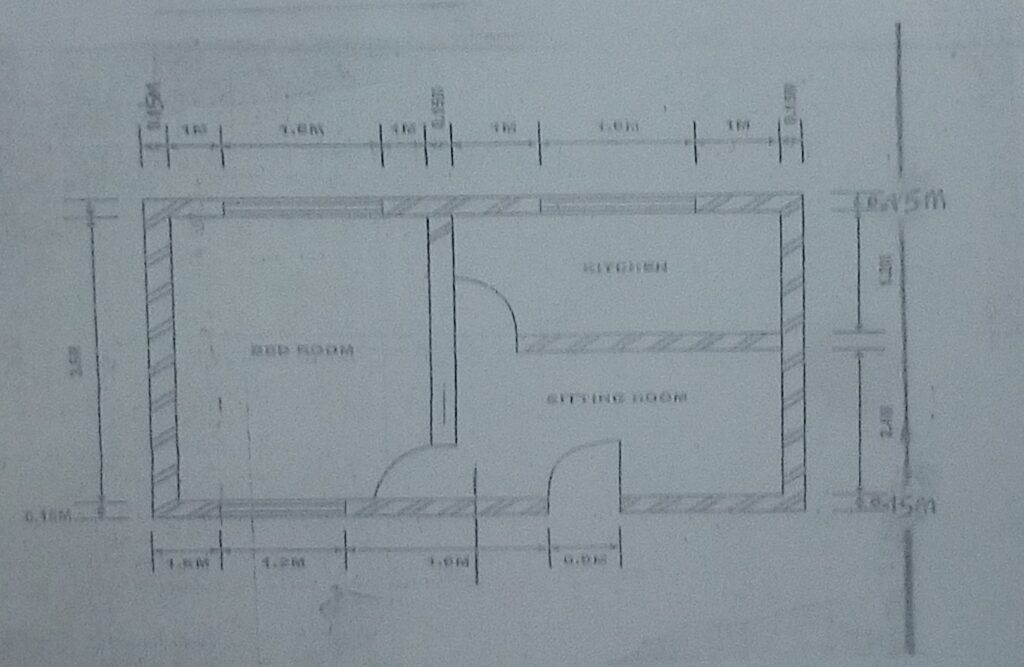
Solution
a, Motion is the movement of an object from one place to another.
b, Linear motion and Rotary motion
c, snips, Hack saw & chisel.
Assignment
Answer the following NECO Question.
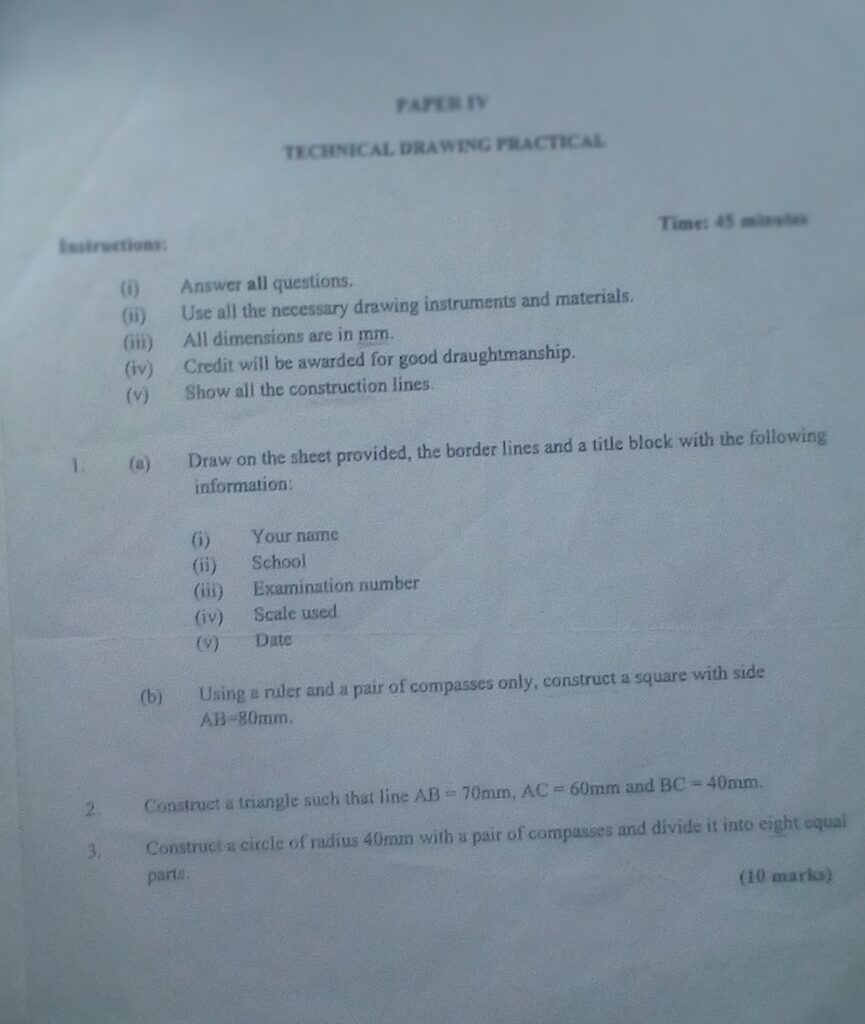
Lesson 2
Date: 25/06/2020
Topic: Review of NECO Practical Questions
With your Drawing instruments, balance on your Drawing board and answer the following practical Questions.

Using the form or email below:
akinsamgambol@gmail.com.
Write your name, subject, class,topic and email.
LESSON 1 JSS 3 - Basic TechnologyDate : 16/06/2020
Topic : Isometric and Oblique Drawings
Isometric drawing is a three dimensional drawing of an object which shows the real views of an object as it appears. It’s drawn by generating the view in a process known as projection. i.e drawing of projection lines.
Isometric Axes
Isometric axes are lines that are drawn inclined at an angle 30 degrees to the horizontal.
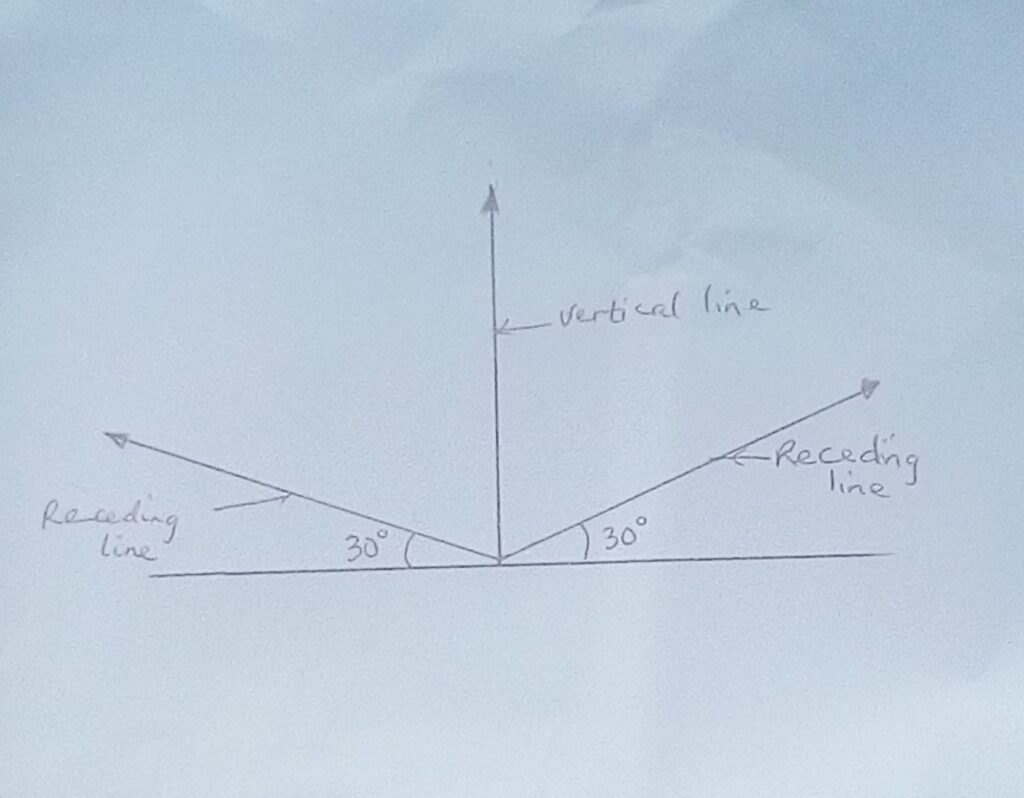
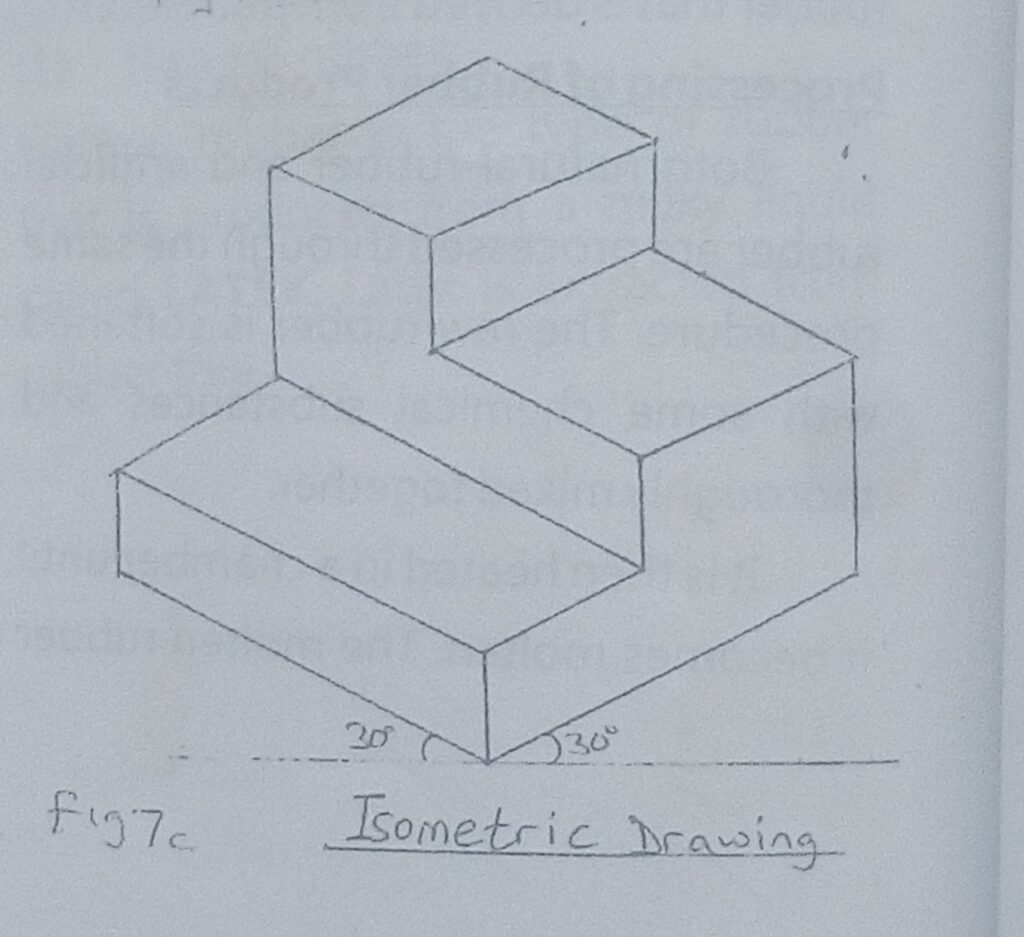
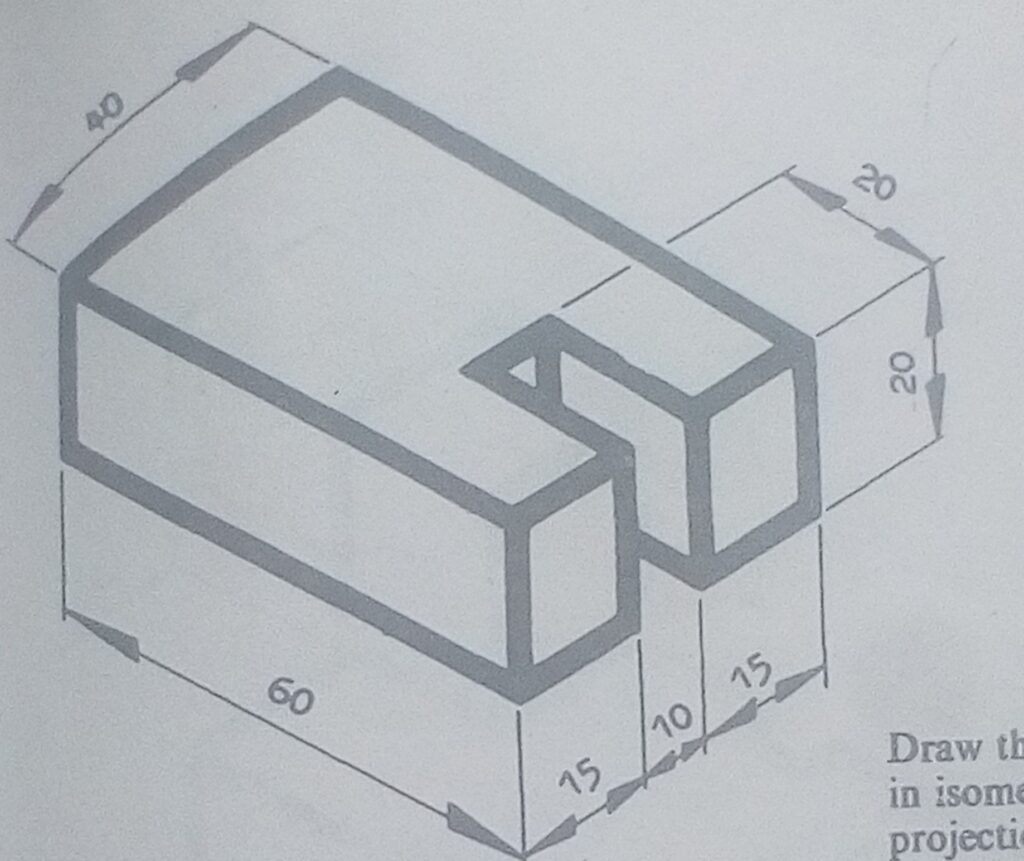

Oblique Drawing
Oblique drawing is a method of drawing in which one side lies horizontal while the other is inclined at 45 degrees to the horizontal.
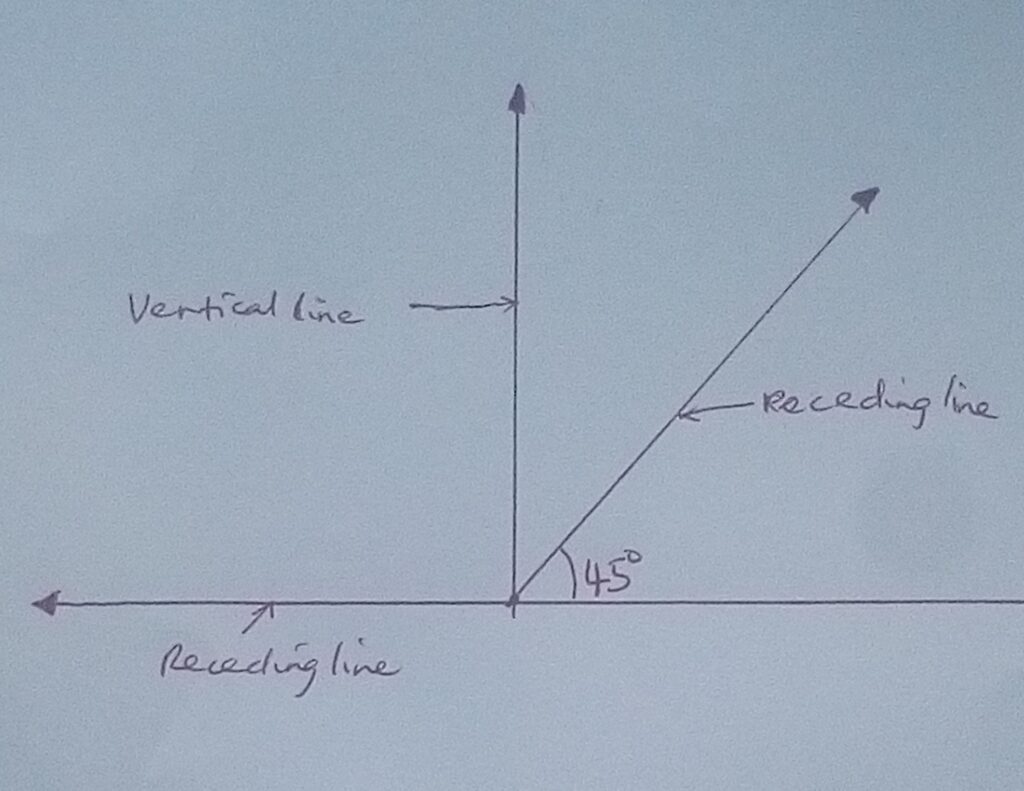
Assignment
1. Define Isometric Drawing.
2.Draw an isometric view of a cube tank of side 50mm.
3.Draw an Oblique view of the cubic tank of side 60mm.
LESSON 2 Date : 18/06/2020 Topic : Orthographic Drawing ( NECO Past Questions). Orthographic Drawing is the drawing of an object in two dimensional views. It involves the use of two planes i.e vertical plane and horizontal plane. These planes intersect each other to divide the space into four quadrants. In orthographic Drawing, the three views that can be projected :. i. The front elevation, ii.The plan, III.The end or side elevation
Angles of Projection
There are two types of projection. First angle projection

Third angle projection
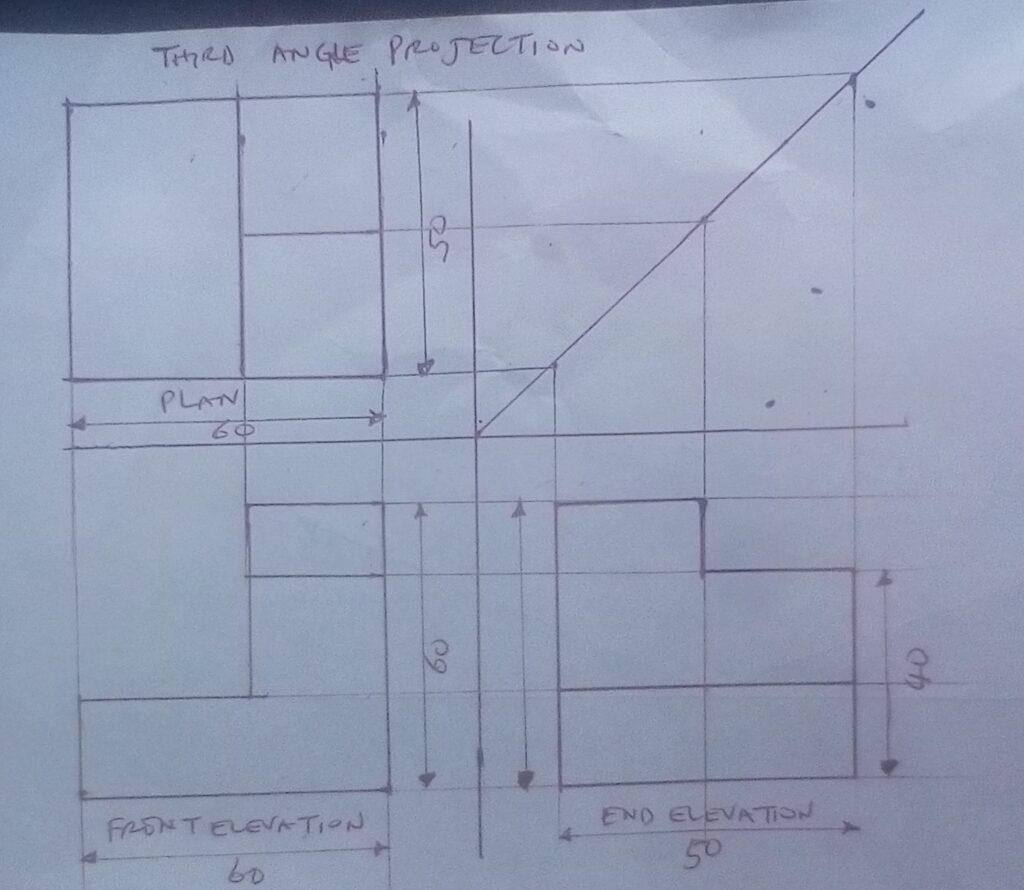
Assignments
Practical Drawing (NECO)
Use the necessary drawing instruments and materials.
All dimensions are in millimes(mm).
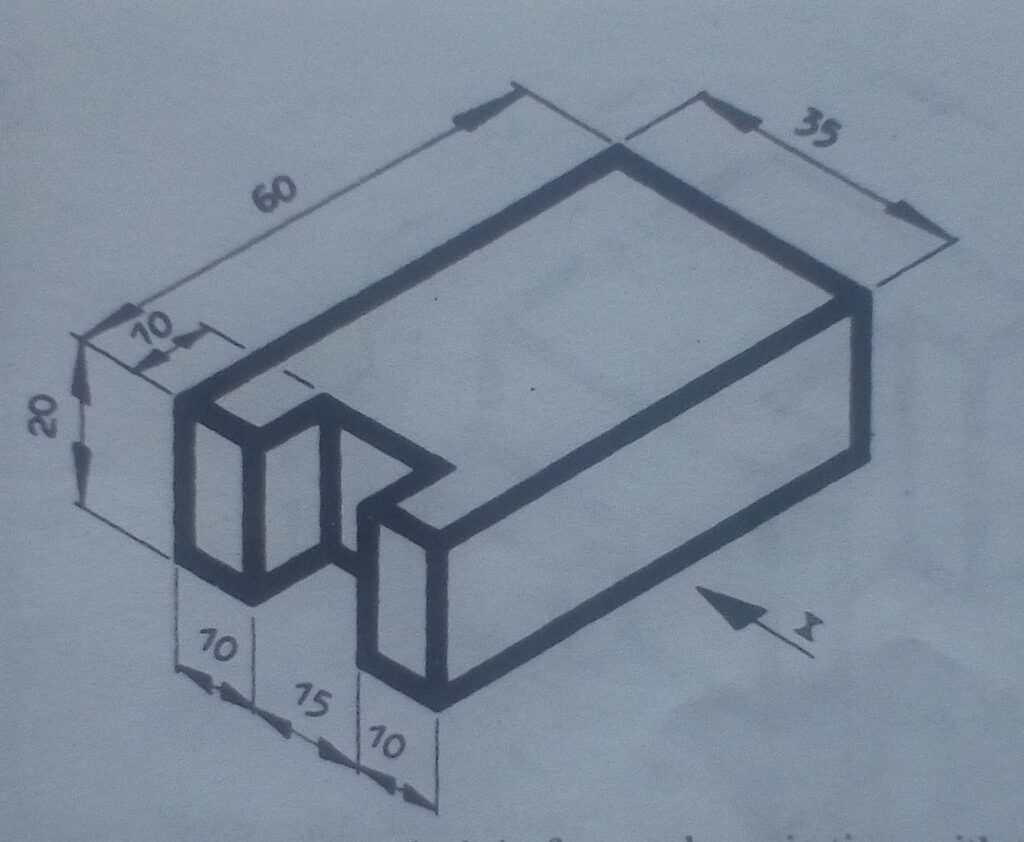
1a. The arrow X indicates the front elevation of a shape block shown in the diagram above. Draw in first angle projection, the following views of the block:
I. Front elevation
II. The plan
III. Left end elevation
2a.What is a Triangle?
b.Name three types of Triangle.
c. Construct an angle of 45 degrees using compass.
Clearly show all the construction lines.
Using the form or email below:
akinsamgambol@gmail.com
Write your name ,subject ,class ,topic and email.
Date: o9/06/2020
Topic : Quadrilaterals
A quardrilateral is a 4 sided plane figure.
Examples of Quadrilaterals
A square has 4 equal sides. All its angles are right angles.
A rectangle has its opposite sides equal and all its angles are right angles.
A rhombus has all its sides equal. Its angles are other than right angles.
A parallelogram has its opposite sides equal. Its angles are other than right angles.
A trapezium has 2 opposite sides parallel.
A trapezoid has 4 unequal sides and angles.
A deltoid or kite has its adjacent pairs of sides of equal length.
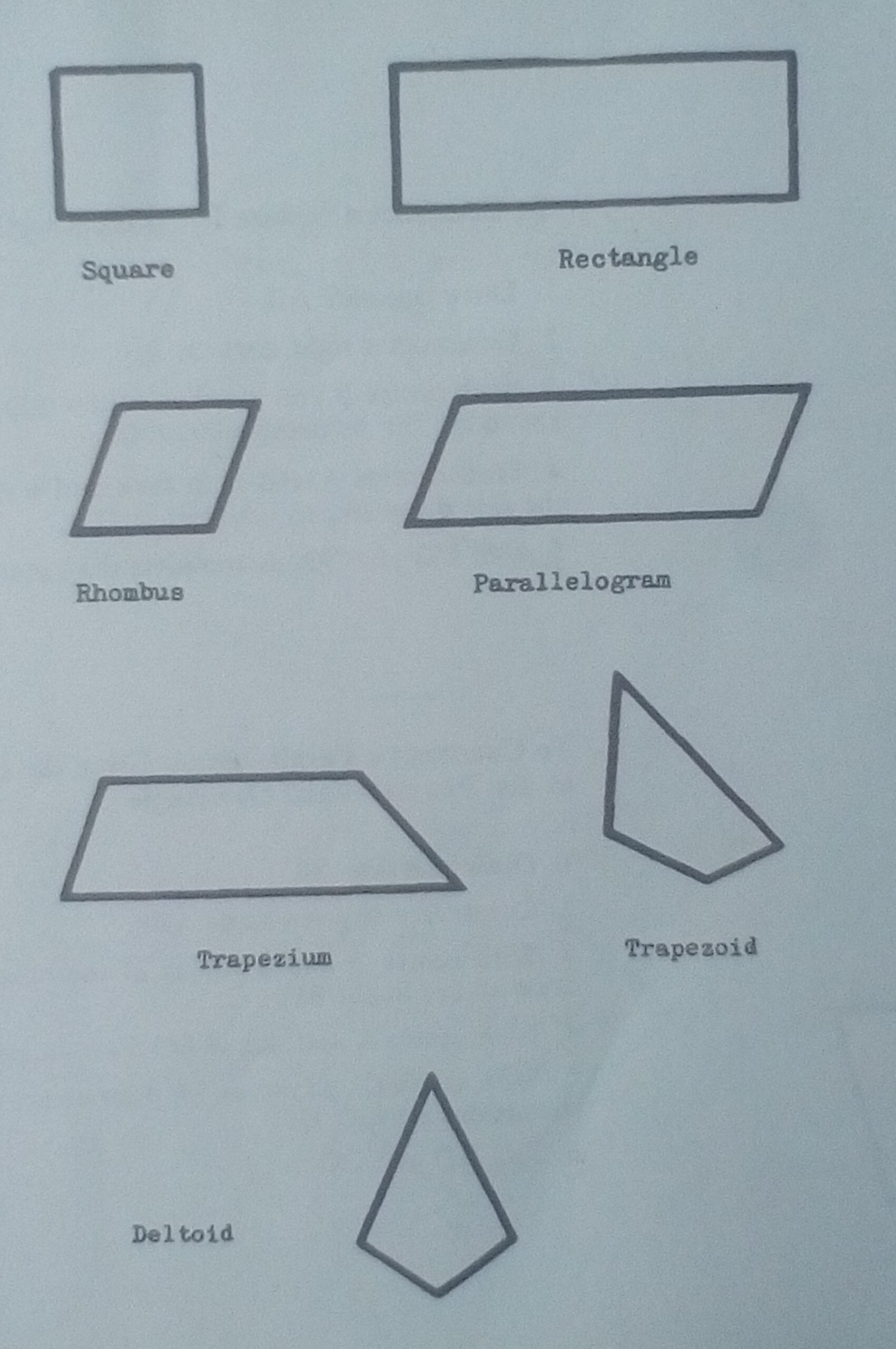
CONSTRUCTION OF A SQUARE
To construct a Square given the length of side.
Procedure:
- Draw one side AB=60mm.
- Construct a right angle at B.
- With centre B and a radius of the side, draw an an arc to cut the perpendicular at C.
- With centres A and C in turn and a radius of the side, draw arcs to intersect at D.
- Join CD and DA to complete the square.
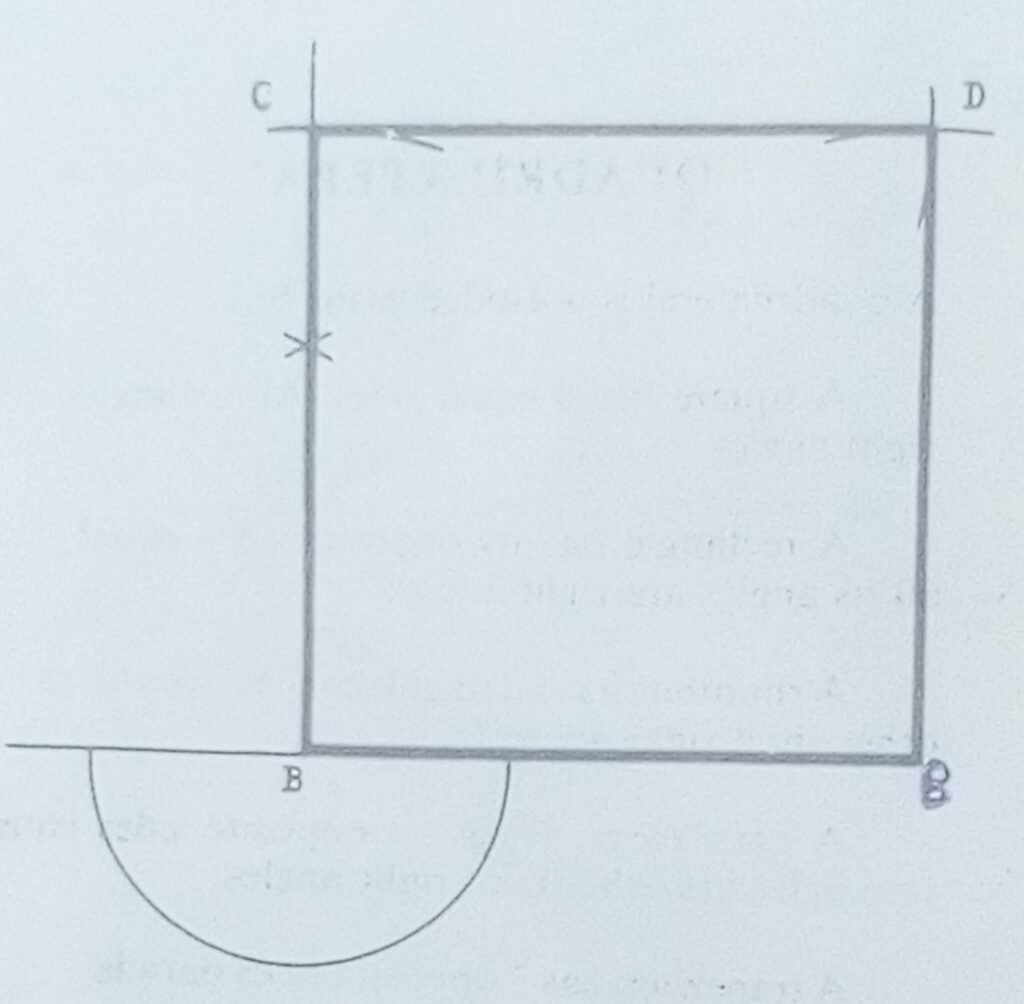
Assignment:
Considering the application above, construct a Rectangle of sides 80mm by 50mm using the form or email below:
akinsamgambol@gmail.com
Write your name ,subject ,class ,topic and email
LESSON 2
Date:10/06/2020
Topic: Inscribing figures
An inscribed figure is a figure drawn inside a given one.
To Inscribe a square in a circle.
Procedure:
- Draw the given circle of radius 30mm.
- Draw the diameter AB and CD at right angles.
- Draw lines AC, CB, BD and DA to complete the square.
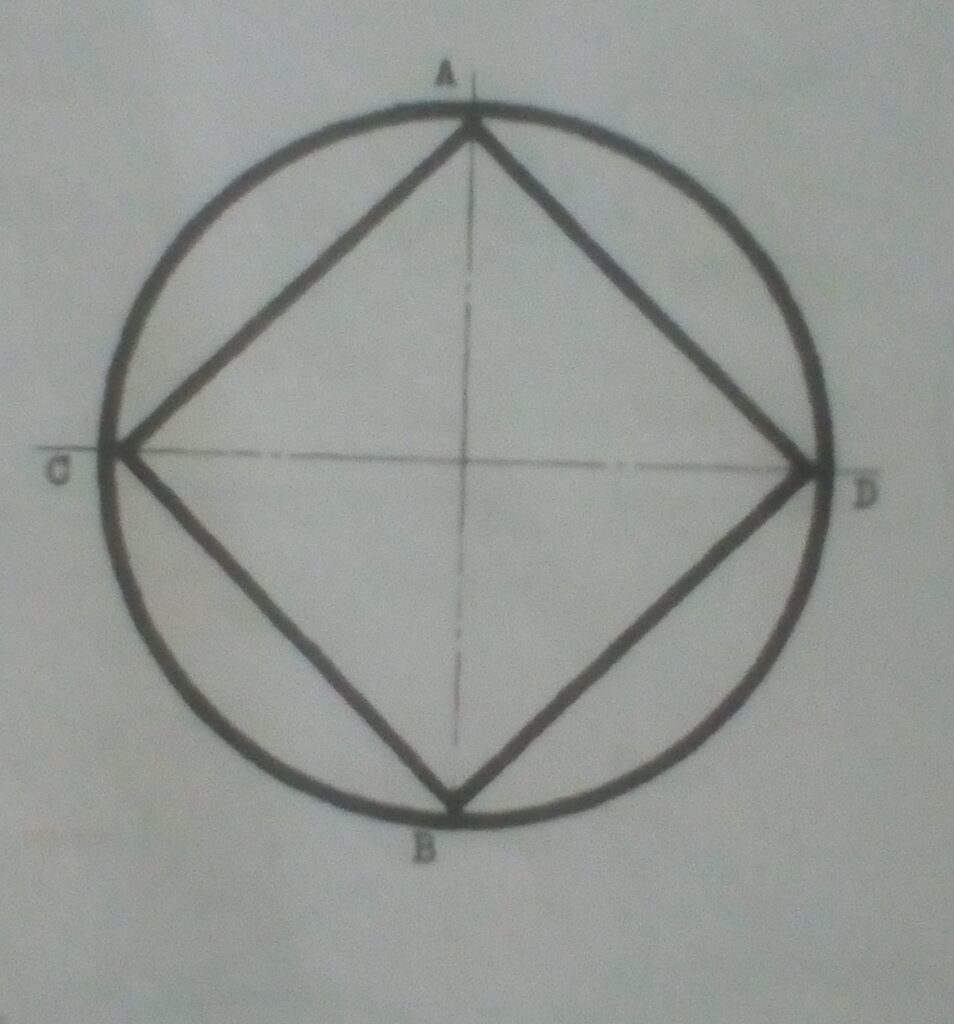
With the aid of compass, construct an Equilateral triangle in a circle.
Using the form or email below:
akinsamgambol@gmail.com
Write your name, subject ,class, topic and email
JSS 3- Basic Technology
Date: 04/06/2020
Topic: Construction of Trangles
A Triangle is a plane figure with three sides.
A right angled triangle has one angle 90 degrees.Theside opposite the right angle is called hypotenuse. An equilateral triangle has three equal sides and angles. An isosceles triangle has two equal sides and angles.
T0 construct any Triangle given the length of the three sides.
Procedure:
- Draw one side AB.
ii. with center A and radius of one of the remaining sides, draw an arc.
iii. with center B and a radius of one of the remaining sides, draw an arc to intersect the previous one at C.
III. JoinA and B to meet the point of intersection of the two arcs at C.

Assignment
Construct a Right angled Triangle ABC with AB = 50mm , <BAC=90degrees and AC=70mm.
Using the form or email below:
Write your name, subject, class , Topic and e-mail.
WEEK THREE
LESSON ONE
JSS 3- Basic Technology
Date: 02/06/2020
Topic: DIVISION OF A CIRCLE INTO EQUAL PARTS.
A circle is a plane figurebounded by a curved line called circumference. It has parts like Diameter, Radius, Arc, sector, segment,chord, Quadrant and Tangent.
Circle is the same as 360°. You can divide a circle into smaller portions. A part of a circle is called an arc and an arc is named according to its angle. Arcs are divided into minor arcs (0° < v < 180°), major arcs (180° < v < 360°) and semicircles (v = 180°).
1.Dividing a circle into four equal parts
Procedure:
- Draw a horizontal diameterAB
- Then, drawdiameter CD perpendicular to AB.

2.Dividing a circle into eight equal parts using 45 degrees set -square.
Procedure:
I.Draw a horizontal diameter AB
ii. Draw diameter CD perpendicular to AB just like the previous one.
III. Then, place your 45degrees square on your Tee- square to draw an incline line passing through the center O and diving angle 90 degrees on each side.

3. Dividing a circle into eight equal parts using a compass.
Procedure:
- Draw a horizontal diameter AB.
- Draw diameter CD perpendicular to AB as usual.
III. Place your compass at center A,B,C,D extend your compass to any convenient radius, then, draw arcs.
Iv. Join the intersection of the two arcs with a straight line passing through the center O.
Assignment.
Divide a circle into Twelve equal parts using your 30,60degrees set- squares.
Using the form or email below:
Write your name, subject, class, Topic & email.
Date: 26/05/2020
LESSON 2
How to construct an angle 30 degree
Procedure
| 1. Draw a line segment which will become one side of the angle. (Skip this step if you are given this line.) The exact length is not important. Label it PQ. P will be the angle’s vertex. |  |
| 2. Set the compasses on P, and set its width to any convenient setting. |  |
| 3. Draw an arc across PQ and up over above the point P. Label the point where it crosses PQ as point S. |  |
| 4. Without changing the compasses’ width, move the compasses to the point S. Draw a broad arc that crosses the first one and goes well to the right. Label the point where the two arcs cross as point T. |  |
| 5. Without changing the compasses’ width, move the compasses to the point T, and draw an arc across the previous arc, creating point R. |  |
| 6. Draw a line from P to R. |  |
| Done. The angle QPR has a measure of 30° |  |
Use the knowledge of the construction of angle 60 degrees and 30 degrees to construct angle 15 degrees.
Using the forms or email below
akinsamgambol@gmail.com
Write your name,class,topic and email.
BISECTION OF ANGELS
Bisection of Angle means dividing an angle into two equal(congruent )parts without actually measuring the angle.
This construction is done with the aid of compass and straight edge ruler as follows
To bisect a given Angle
Procedure 1. Draw the given angle AOB.
2 . with centre O and any convenient radius draw an arc to cut OA at C and OB at D.
3. With centre C and any radius draw an arc.
4. With centre D and the same radius draw an arc to interest the previous one.
5. Draw a straight line from centre O to meet the centre of the two arcs.This is the bisector.
1. Construct the following angles:
a,45 degrees
b,60 degrees
Using the form or email below
akinsamgambol@gmail.com
Write your name,your subject,topic,class and email.
BISECTION OF A LINE
Bisection of a Line is a process of dividing line into two equal parts using a pair of compass. The object to be constructed is outlined with thick line while other lines of construction remain as thin line.
To bisect a given Line
Procedure:
- Draw the given line AB
- With center A and any radius greater than half AB, draw arcs above and below the line.
- With center B, draw arcs of the same radius to cut the previous ones.
- The a line draw through the intersection of the arcs will bisect the given line AB at C.

TO CONSTRUCT A PERPENDICULAR AT A GIVEN POINT ON A STRAIGHT LINE
Procedure:
1.Draw the given line AB. 2.Mark the given point C. 3.With center C and any convenient radius, draw the semicircle DE. 4.With center D and E and any convenient radius, draw arcs to intersect at F. 5.A line drawn from C through the intersection of the arcs is the perpendicular.

Assignment Answer these questions using the form or e- mail below . Write your Name, class, subject Name & e- mail in the box.
E- mail: akinsamgambol@gmail.com. 1.Contruct the following angles: 90 degrees , 45 degrees. 2.Divide line AB =80mm into 8 equal parts.
No Fields Found.LESSON 1
DRAWING PRACTICE in Basic Technology.
Technical Drawing as a Board practice is a universal language that is used for communication among technical people in Engineering work.
GEOMETRICAL CONSTRUCTION
This is a method of drawing that involves the use of a pair of compass with a pencil to construct arcs, circles, semicircles, bisecting lines and angles.
Examples of Technical people: Engineers, Architects, Land surveyors, Quantity surveyors,Builders, Draughtsmen and Artisans.
IMPORTANCE OF TECHNICAL DRAWING
- It gives clear graphical illustration of the project to be designed for manufacturing industries.
- It helps other people to see and interpret what they have in mind.
Instruments and materials used in practical Technical Drawing.
Drawing Board, Tee- Square, set Squares (30,60 & 45degrees), protractor,compass, Divider, scale rule, metric rule, french curve, lettering set, sharpener, Drawing paper, pencil, eraser and cello tape or paper clip.
Types of pencils
1.soft pencils- These are soft and black pencils ,i.e B,2B,3B…………..8B
2. Hard pencils: These prncils are hard, i.e H,2H3H,………….8H
Pencils recommended for practical Technical Drawing are:
H OR 2H- used for construction while HB – used for letting and free hand sketching.
Types of Drawing papers and sizes.
AO-841MM X 1189MM, A1-841MM X 594MM, A2-420MM X 594MM, A3-420MM X 297MM,A4- 210MM X 297MM.
But A2-420MM X 594MM is the recommended Drawing paper size and Board for secondary school education.
Typesetting of lines used for practical Technical Drawing in Basic Technology.
- Thick line-It is used for visible outlines
- Thin line- It is used for construction, dimensions, projection & hatching.
- Thick long chain-It is used for cutting planes.
- Thin long chain- It is used for center line.
- Thin short dashes- It is used for hidden details.
- Zig -Zag line- It is used for long break line.
- Thick wavy line+ It is used for short break line, irregular boundaries & limits of partial views.
- Dimension line- It is used for extension of measurement.
Assignment
Answer these questions using the form (s) below:
- Why is the teaching of practical Technical Drawing important in JS3 class?.
- State the uses of the following Drawing materials: Tee-square, set-squares, Dividers, B pencils and HB Pencils.
